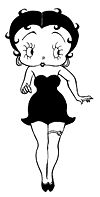- Cuteness
-
"Cute" and "Cutie" redirect here. For other uses, see Cute (disambiguation) and Cutie (disambiguation).

 Physical anthropologist Barry Bogin considers Betty Boop to be an examplar of neoteny.[1]
Physical anthropologist Barry Bogin considers Betty Boop to be an examplar of neoteny.[1]Cuteness is the appeal commonly associated with neoteny.
Contents
Cuteness effects
Humans respond favorably to a neotenized appearance[2] A neotenized appearance elicits sympathy from humans[3] as well as protective urges.[2] People with cuter faces are perceived to be "warmer,"[4] more honest[5] and more employable for jobs.[6]
Not only humans, but other "adult mammals" are hard-wired to have their "aggressive behavior" inhibited and exhibit "caring" and "nurturing" attitudes toward the appearance of "mammalian infants".[7]
Role in evolution
Human children have evolved to stay neotenized longer, so human adults will care for them longer due to their cuteness.[7]
Humans have more neotenized skulls than Neanderthals,[8] so anthropologist Björn Kurtén believes humans may have achieved territorial dominance over Neanderthals by virtue of their cuter faces which enabled them to play off the Neanderthals nurturing instincts.
In cartoons, toys and advertising
Stephen Jay Gould claims that over the past 50 years Mickey Mouse has been drawn cuter to make him more appealing by increasing the size of his eyes, shortening his limbs and reducing the projection of his snout.[9] Gould contrasts the neotenized Mickey Mouse with the Goofy who portrays "exaggerated adult" features such as a proportionally "small head" and "prominent snout".[9] Moreover, Gould adds, Disney villains and characters who exhibit bad behavior such as Donald also tend to have a less cute appearance.[9]
The importance of cute characters in Japan can be seen in Hello Kitty and Pokémon.[3]
Teddy bears are made cute today, but they originally had long snouts and small eyes that were not cute.[10]
In other animals
Stephen Jay Gould claims that animals with small snouts and large eyes like cats are considered cute by humans, while animals with long snouts and small eyes are not.[9]
In the USA, the more neotenized an animal is the more "endearing" and "charming" it is considered to appear and the greater moral value ascribed to it.[11]
Specific animals
Unlike an adult triceratops, a baby triceratops lacked large protruding horns, a large snout, and large boney plate crown, but had huge eyes, suggesting that cuteness may be a very, very old survival strategy for young offspring.[12]
Michel Gauthier-Clerc, a penguin researcher, claims humans perceive penguins to be cute due their waddle-walk which resembles a human baby and their upright posture.[13]
See also
References
- ^ Bogin, B. (1999). Patterns of Human Growth. Cambridge University Press, NY.
- ^ a b Flora, C. (2008). Psychology Today. Cute on the Brain. Accessed May 4, 2011 from http://pt5.psychologytoday.com/blog/brainstorm/200803/cute-the-brain
- ^ a b Garger. I. Hello Kitty: One Nation Under Cute. Psychology Today, Mar/Apr 2007.
- ^ "The contribution of facial maturity to sex-role stereotypes", H. Friedman, & L.A. Zebrowitz, Personality and Social Psychology Bulletin, 18, 430-438, 1992
- ^ Babyfaces, Trait Inferences, and Company Evaluations in a Public Relations Crisis, Gerald Gorn, Yuwei Jiang, and Gita Johar, Journal of Consumer Research, vol 58, no 1, June 2008
- ^ Keating, C.F. Do Babyfaced Adults Receive More Help? The (Cross-Cultural) Case of the Lost Resume. Journal of Nonverbal Behavior Volume 27, Number 2, 89-109, DOI: 10.1023/A:1023962425692.
- ^ a b Smith, J.M. (1958). The theory of evolution. Cambridge University Press.
- ^ a b Montagu, A. (1989). Growing Young. Bergin & Garvey: CT.
- ^ a b c d Gould. S.J. A Biological Homage to Mickey Mouse, in The Panda's Thumb: More Reflections in Natural History. W.W. Norton & Company, 1980.
- ^ Bryne, R.W. Animal Evolution: Foxy Friends. In Current Biology Vol 15 No 3
- ^ Lawrence, E. A. (1986). Neoteny in American perceptions of animals. Journal of Psychoanalytic Anthropology, Vol 9(1), 41-54.
- ^ 03.06.2006 - Smallest Triceratops skull described
- ^ Angier, N. How kawaii' Taipei Times. Retrieved May 21, 2011, from http://www.taipeitimes.com/News/feat/archives/2006/01/08/2003288095/4
Categories:- Ethology
- Social psychology
- Developmental biology
- Physical attractiveness
- Concepts in aesthetics
Wikimedia Foundation. 2010.

